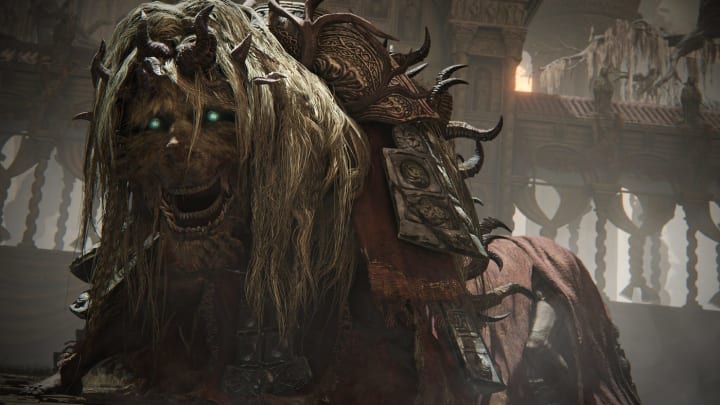Elden Ring: Shadow of the Erdtree review – FromSoftware flexes its open-world design

There are two types of FromSoftware game players: those who pretend they understand the lore and me. Shadow of the Erdtree likely has plenty of moments for the former – the people who can somehow decipher the meanings behind Rumpelstiltskin-riddle NPC dialogue or the item description of a pickled carotid artery – but it also has plenty of moments for me, an oblivious boy who likes grand landscapes and cool swords.
Riding into the Land of Shadow is as awe-inspiring as the first time you stepped out of the dank cave and into the overworld of Elden Ring. There’s a sense you’re inside the folds of the universe, underneath reality, despite the clouds above telling you otherwise. You’re occupying a space that shouldn’t exist on a plane not meant for human eyes.
The gilded light of the Erdtree doesn’t reach this place – only its shadow, its mangled roots dripping with hot corruption. Spectral gravestones dot the landscape as if they are remnants of the Tarnished from that other sphere, whether it exists above, below, or alongside this eldrich landscape. Like I said, I couldn’t tell you – some YouTuber will probably make a 20-hour video about it.
Giant ravens perch on gravestones too large to have been made for humans, while pious urchins sit dried out and dead, hands clasped in eternal prayer. Even if you don’t know what the hell is going on, it’s a vibe. Every frame could be a painting.
Shadow of the Erdtree sees FromSoftware perfect the open-world formula, creating a much smaller but many times more dense landscape where every alternate path could lead to a discovery. If the hulking wicker giants, humanoid insects, and angry spirits don’t get you, the choice paralysis will.
At one point, I checked a route off the main path for items, except that route took me down a ladder to a poisoned swamp with three other new routes, two of which lead to another area with another spider’s web of corridors and open areas, all interconnected in a way that made my head spin. Seemingly inconsequential dungeons unfold and expand, while every corridor could potentially turn into a multi-hour distraction from your main quest.
Impossible bridges hang on the horizon and you know you will be hiking across them at some point – for now, though, they remain out of reach. It’s masterful.
In linear games, future areas are often teased in advance. Think about how Naughty Dog frames landmarks in the distance in The Last of Us, giving the world a sense of logic despite there only being a single route that you can’t deviate from to reach them. FromSoftware replicates this across an open world, framing major landmarks thoughtfully as you enter their view from one of dozens of possible vantage points. You don’t follow waypoints – you see something interesting and try to work out how to reach it, whether by cartography or by scanning the land with your eyes.
Before you know it, you’re charging across those bridges on horseback, looking out over the land you’ve just explored as a magus curls fire from his fingertips, creating clouds overhead that rain down magma on your advance. These moments would be scripted set pieces in other games, but here they’re just level design and systems working together in perfect harmony.
It’s not without issues, however. Giving the player this freedom comes with development challenges – especially in a game where players test the boundaries in search of secrets. There were a couple of times I jumped my way into an area looking for items, only to find I’d gotten myself stuck (easily solved by fast-traveling, but still not ideal). There are also a couple of spots on the map where FromSoftware seemingly didn’t turn on collision, meaning you can walk through the floor and find yourself in a similar situation. Not game-breaking by any means, but it’s not the sort of issue you’d get inside a more linear framework. For me, it’s an acceptable trade-off – especially as these will no doubt get fixed in a couple of patches.
My only other minor criticism is the uneven challenge of the bosses. Most of the DLC can be steamrolled through with a sufficiently leveled character and a good build, which means you never get to appreciate their movesets – a shame when their visual designs are so striking. Then, on the flip side, there are a couple of late-game bosses – and one optional boss especially – that will make you want to bite your controller in half. It’s okay, though, I needed to be humbled, and when I finally beat it, a wash of that feeling only FromSoftware can provide came over me. It was worth the pain.
Shadow of the Erdtree doesn’t do anything particularly surprising for Elden Ring players, but it’s worth the price of admission just to see FromSoftware flex its world design expertise in a more compact playspace. It also fits perfectly into the middle of the main game, which means you can step into the Land of Shadow and return to the main world armed to the teeth with an arsenal of fun and unique new weapons, from hulking katanas to reverse grip swords, beast claws, and poison bottles. Whether you’re here for the lore, the swords, or the vibes, Shadow of the Erdtree bolsters what’s already one of the best open-world games ever made.
Score 10/10
Check our Shadow of the Erdtree release times post for information on when you can start playing.
Version tested: PC
